
It is incredible to see how far we have come regarding Artificial Intelligence and its scope. Since its ideation and introduction in the mid-1940s as an artificial neuron to the present times, AI has become an integral part of our day-to-day lives.
Looking back, the original purpose of Artificial Intelligence was to simplify business processes, like how AI-powered computers and robots automated laborious tasks in banking and manufacturing. However, it was in the 1990s, the introduction of Machine Learning and data-driven approaches, that brought a major development in AI and its effect on the overall organizational structure.
By the 2000s Artificial Intelligence diversified and spread into newer domains with Natural Language Processing, computer vision, and robotics making the way for revolutionary AI trends to emerge and eventually opening the doors for custom solutions, smart technology integrations, and many more.
The latest statistics about Artificial Intelligence mention its present-day impact in different industries while claiming a promising future. Given the current scenario, AI is set to revolutionize every inch of the business landscape.
To solidify our claims and understand the widespread scope of AI, we have carefully compiled a list of Artificial Intelligence statistics and trends that we have shared with you in this blog.
- Artificial Intelligence Trends and Statistics
- Top 20 Artificial Intelligence Growth Statistics
- The Scope of AI Market Size
- Industry-Based Artificial Intelligence Statistics
- AI in the Retail Industry
- AI in Business Statistics
- AI in Sales and Marketing
- Machine Learning and AI Facts
- Artificial Intelligence and Statistics 2023
- Future of Artificial Intelligence
- Things to Consider When Designing an AI-Driven Business Strategy
- The Ethical Dilemma
- To Conclude
Artificial Intelligence Trends and Statistics
Artificial Intelligence finally entered the real world in the 1950s, which marked the beginning of a rollercoaster ride filled with ups and downs. After numerous golden moments and challenging times, AI made its first major breakthrough in 1997, when IBM’s Deep Blue became the first computer to beat a world chess champion.
The graph finally saw steady growth in the late 1990s and early 2000s, and there has been no turning back from there. Since then, AI/ML development services have been simplifying business operations with smart solutions assisting business operations, enhancing customer experience, improving decision-making, etc.
We have categorized the trends and statistics about Artificial Intelligence into the following categories:
- Top 20 growth statistics
- AI and its scope
- Industry-based AI trends
- Machine Learning and AI trends
- The AI trends for 2023
Top 20 Artificial Intelligence Growth Statistics
1. At present, the AI market is worth $328.34 Billion globally.
2. Between 2021 and 2030, the AI market is expected to grow by 38.1% CAGR.
3. The expected yearly growth rate of the AI market is at least 120%.
4. By 2025, Artificial Intelligence will generate around 97 Million new jobs.
5. By 2026, the AI market is anticipated to reach $299.54 Billion in the US alone.
6. The adoption of AI will also lead to the growth of global GDP by $15.7 Trillion by 2030.
7. 8 Billion AI-powered voice assistants will be developed by the end of 2023.
8. AI-based startups have seen a six-fold increase in investments since 2000.
9. By the next seven years, AI’s industry value is expected to grow by 13 times.
10. By 2030, the value of the global AI market will reach $1,811.8.
11. AI has become the number one priority for 83% of businesses across the globe.
12. The global market is expected to reach $266.92 Billion by 2027 according to Gartner reports.
13. As per one of the Netflix's tech blogs, it has saved $1 Billion annually using Machine Learning to generate customized user recommendations.
14. AI adoption has improved the productivity of 61% of employees.
15. AI has been a cost-effective option for 54% of organizations.
16. Currently, 35% of companies around the globe have successfully integrated AI into their system.
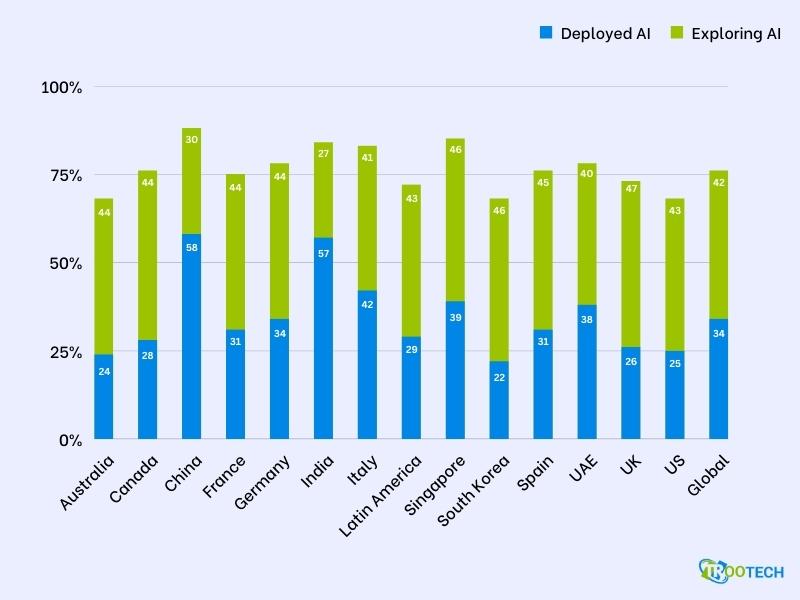
17. 42% of businesses have given a positive response and have reported using AI in the near future.
18. More than 80% of executives in the retail and consumer industries are planning to integrate AI automation to augment their business by 2025.
19. 38% of medical providers prefer using digital tools like computers as a part of their treatment process.
20. By 2030 China will have a 26.1% global market share making it a world leader in AI technology.
The Scope of AI Market Size
AI is gradually getting increasingly integrated into the existing system. With huge investments in AI and increased demand for AI-powered products by businesses, the AI market is expected to grow significantly in the coming years; some facts and figures supporting this claim are:
21. By 2030, the global AI market value is anticipated to grow from $136 Billion to $1811.8 Billion.
As per the Artificial Intelligence statistics, AI will become an essential part of sustained economic growth throughout the decade because of its transformative capabilities across diverse industries.
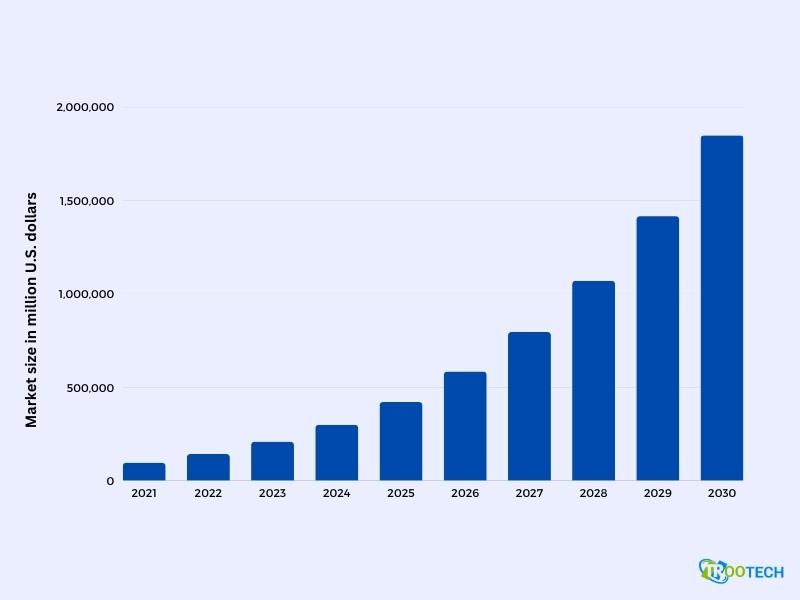
22. The fourth industrial revolution will generate a $7 Trillion value by 2025 with AI being a major contributor.
AI's capability to automate processes, generate relevant data for better decision-making, and improve customer services will play a key role in the fourth industrial revolution.
23. The AI market size will reach $407 Billion by the year 2027.
With a high revenue generation of approximately $86.9 Billion in the past, the AI market is likely to expand and reach $407 Billion by 2027.
24. It is estimated that by 2030, AI will have a net impact of 21% on the US economic growth.
By 2030, the economic impact of AI on the US GDP is predicted to be 21%
25. ChatGPT got 1 Million users within the first five days of its launch.
ChatGPT attracted an incredible amount of 1 Million users within the first five days.
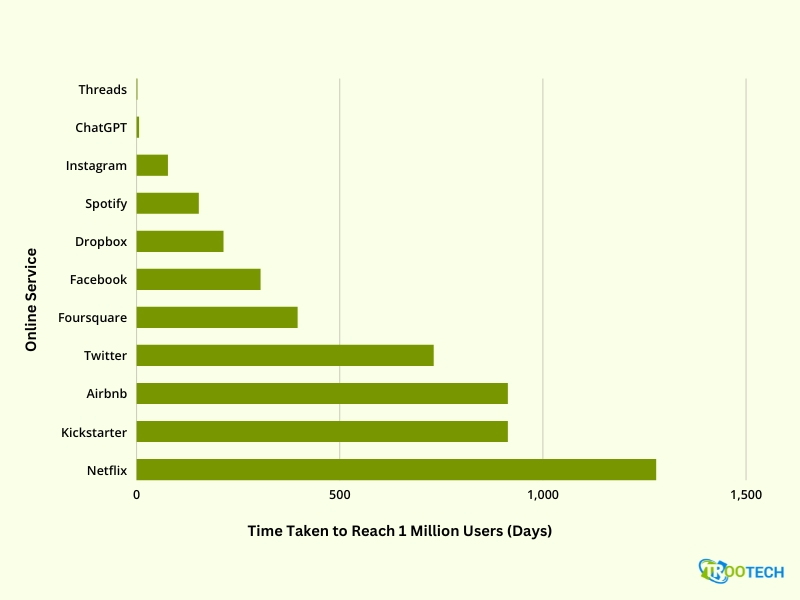
26. It is estimated that by 2030, one in ten vehicles will be self-driven.
The number of autonomous vehicles is predicted to increase to 62.4 Million, thus implying that approximately 10% of all vehicles will be AI-driven.
27. 64% of companies expect improved productivity with AI.
As per the Forbes Advisor survey, 64% of business owners believe that AI will enhance the operational efficiency of the organization, thereby boosting productivity.
28. At present, the global revenue of the AI software market is over $50 Billion.
With a current revenue of about $50 Billion, the market is expected to expand in the coming years.
29. 9 out of 10 businesses affirm that AI will offer them a competitive edge.
87% of MNCs support that AI integration can benefit their business growth in today’s highly competitive market.
30. By 2030, AI will hold a major share of China’s GDP.
According to the Artificial Intelligence growth statistics, China’s 26.1% of GDP will come from AI.
31. North America and the United Arab Emirates will be the major contributors to the world’s technological advancements by 2030.
By 2030, North America will contribute approximately 14.5% followed by the United Arab Emirates, with 13.5% of the world’s technology to other economies.
32. According to a PwC publication, the potential impact of AI in the Middle East’s economy will be equivalent to about US$320 billion.
By 2030, the Middle East’s economy is expected to gain 2% of the total benefit of AI with Saudi Arabia having the largest share of over US$135.3 billion, which is equivalent to 12.4% of the GDP.
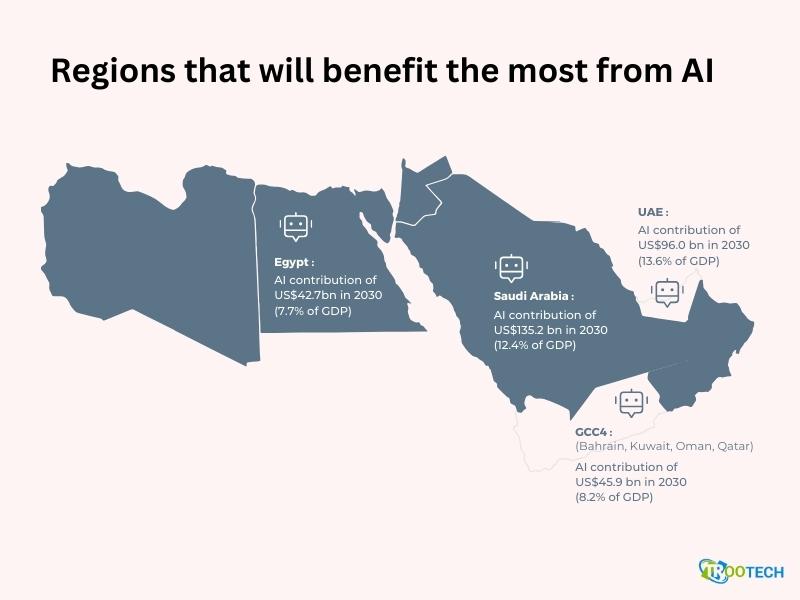
Integrate AI-driven Technologies to Get a Competitive Edge and Maintain Relevancy
Streamline business processes and augment growth with our top AI solutions
Industry-Based Artificial Intelligence Statistics
While these generalized facts show the huge impact Artificial Intelligence has been making across all spheres of life. But it’s also worth noting that it paved the way for custom software development.
Developers have delivered numerous tailored solutions powered by Artificial Intelligence for fulfilling industry-specific requests. These smart solutions have been designed to handle the issues unique to a particular domain, industry, or business, thereby making a significant impact on operational efficiency.
Some of the industry-specific services of Artificial intelligence growth statistics are:
33. Financial services will improve significantly with the integration of AI in banking.
The financial services organizations are planning to invest $11 Billion, which will be used to integrate smart AI-driven technologies to make the system more customer-friendly and secure, along with other integrations.
34. By 2030, about 10% of nursing tasks might be automated with AI.
As per the WHO’s reports, there will be a shortage of healthcare professionals by 2030, which will be mitigated with the help of AI-powered healthcare software development services that will take up 10% of the tasks.
35. AI implementation has helped businesses make data-based investment decisions and decrease forecasting errors by 20%.
With Artificial Intelligence and statistics, manufacturers can now estimate the demand for the goods to accordingly invest and advertise, thereby reducing one-fourth of prediction errors.
AI in the Retail Industry
AI-driven intelligent solutions are rapidly integrating into the retail industry. It is set to revolutionize both internal management and customer services with its optimized supply chain management, improved product recommendations, AI chatbots, and many more such solutions.
According to Artificial Intelligence growth statistics, it will only grow with new additional feature integrations like Natural Language Processing, optimal data-driven solutions, and highly effective predictive analysis. Some of the stats to show are:
36. The AI statistics are expected to reach $31.18 Billion in the global retail market by 2028.
The value of AI in the retail industry was $4.84 Billion in 2021, which is expected to reach $31.18 Billion by 2028, with a CAGR of about 30.5% between 2021 - 2028.
37. Amazon witnessed about a 225% decrease in “click to ship” time with the help of Machine Learning.
Amazon acquired a robotics startup to automate order management, packing, and shipment in the warehouse. This reduced the average duration of click to ship from 60 - 75 minutes to an average of 15 minutes, thereby improving the overall services.
38. As per the Statista poll, 87% of respondents claimed to use or consider using AI for email marketing and sales predictions.
As per the respondents of 2017’s Statista poll, 61% of businesses affirmed their intent to use AI-driven marketing and sales solutions.
AI in Business Statistics
AI makes it easy for enterprises to handle a massive amount of data, analyze it, and generate accurate insights. This will help businesses identify patterns and improve their decision-making, thereby enhancing the final outcomes.
Many businesses are slowly integrating AI-driven solutions for improved predictions, task automation, and getting real-time insights to match the pace of fast-changing market conditions. Businesses are leveraging Artificial Intelligence statistics to augment rapid expansion and growth.
39. Executives reported an increase in productivity by 52% with the help of AI tools.
The use of automation tools has helped by freeing the workers of the monotonous routine tasks. Thus helping them focus on other important tasks and increasing their productivity.
40. Around 48% of companies have integrated Data Analysis, Machine Learning, and other AI tools to tackle data quality related challenges.
According to Semrush, about 48% of companies have integrated smart AI technologies to improve their data quality.
41. As per 25% of business leaders, AI integration has improved their operational efficiency.
Artificial Intelligence integrations have facilitated businesses to streamline their processes and improve overall efficiency.
42. As per 50% of corporate leaders, AI has been really beneficial in saving them money.
With automation and smart data-driven insights, AI and ML have assisted businesses in improving their decision-making and optimizing operations.
43. 53% of enterprises have integrated AI technology into their system for designing innovative products and services.
AI has been really helpful in brainstorming, prototyping, and developing innovative products and services for numerous businesses.
44. As per 54% of business leaders, Artificial Intelligence has evidently improved their decision-making process.
With the help of Machine Learning, businesses can effectively make data-driven accurate analyses thereby improving their decision-making processes.
AI in Sales and Marketing
Businesses have effectively improved their sales processes and success rates with AI integrations. Today, firms can use Artificial Intelligence statistics to track consumer behavior and patterns. This has significantly improved their practices for better conversion rates.
The marketing department shows similar results regarding AI integration to optimize the system. With Natural Language Processing, personalized marketing campaigns and management marketers can improve their strategies and processes quickly.
Artificial Intelligence can empower businesses and make informed decisions based on accurate data analysis and predictive analytics. This will help them improve the customer experience with personalized services and in turn, will improve the conversion rates.
Impact of AI Integration on Future Job Opportunities
AI has automated and optimized numerous business processes across various industries. However, the current trends are pointing towards the probable automation of numerous jobs thereby replacing humans with AI. Some of them are:
45. Intelligent robots may replace 30% of the workforce by 2030.
As per the experts, by 2030, automated operations will take over and reduce the workforce to less than one-fourth of what it was in 2017.
46. It is estimated that 16% of jobs will be automated in America.
According to Forrester, AI will not only automate the existing jobs, but it will also generate about 9% of employment opportunities thus creating a net loss of 7% of jobs in the US by 2025.
47. Nearly 400 Million people will need a career change by 2030.
It is possible that robotics might eliminate about 30% of occupations, making about 375 Million people change their careers.
48. While the current jobs will be automated, more job opportunities will come up with AI integration.
According to 52% of experts, while AI-driven machines and systems will replace the current jobs, there is a high chance that it will also generate newer job opportunities.
49. The current educational system is in serious need of digital transformation to be prepared for how AI will affect jobs in 2030.
The current education system and the curriculum need to be updated for the students to be prepared for future opportunities with the current knowledge and information.
Our Professionals Have Powered Multiple Industries With Our Contemporary AI Solutions
We are adept at providing industry-specific solutions to match all your requirements
Machine Learning and AI Facts
Machine Learning (ML) is a huge part of current AI solutions, widely used by renowned enterprises across diverse industries like Google, Netflix, Johnson & Johnson, Uber, and many more. Businesses have benefited from improved accuracy and higher efficiency with Machine Learning integrations in their system. Some of the ways of doing so are:
- Simplifying the handling of large amounts of data
- Better predictive capabilities
- Improved decision-making and strategic planning
- Enhanced security with upgraded fraud detection and prevention
Some facts and figures to strengthen the claims about the advantages of Machine Learning are:
50. It is expected that the automotive industry will see a massive increase of 48% in Machine Learning.
Autonomous driving will become more popular with semi or fully autonomous vehicles. Also, designing custom vehicles using AI and ML development services will improve the vehicle’s convenience.
51. Google’s Machine Learning program is said to be about 89% accurate.
The deep learning program by Google has outperformed human pathologists with 15% more efficiency.
52. 20% of the company’s top-level executives use Machine Learning.
As per a report by McKinsey, 20% of C-suite executives worldwide consider Machine Learning to be a crucial part of their business.
Artificial Intelligence and Statistics 2023
Whether IT-based or non-IT, big enterprises or startups, everyone seeks to expand their technological capabilities by adding Artificial Intelligence-powered solutions to their digital infrastructure. Many even hire remote developers by offshoring or outsourcing to enrich their team and its skill set without essentially expanding their actual space.
This is due to the current wave of AI-driven solutions and their benefits. Some of the recent statistics about AI that show its significant impact on the present landscape are:
53. With AI integration, businesses can increase operational efficiency by 40%.
Accenture’s study on the effect of AI across 12 nations showed that the economic growth rates will probably be doubled by 2035. People will feel more productive as they will be able to utilize their time better with the help of AI.
54. Many medium to large-scale businesses are expected to incorporate AI in their business strategy.
As per the MIT Sloan Management Review, about three-fourths of executives think that AI integration can benefit their company’s growth. It will not just improve their productivity but will also give them a better position against their competitors.
55. 47% of organizations have implemented an AI strategy for mobile apps.
As per the 2018 statistics about Artificial Intelligence, approximately half of the top businesses have added AI-driven features to their mobile apps to improve their marketing initiatives with a personalized approach.
56. Artificial Intelligence will improve the lives of 41% of the customers.
The digital landscape is constantly shifting and will be primarily dominated by AI-driven tools and trends. It is also highly probable that India and China will play a major part in adopting this shift.
57. About 33% of consumers believe that they are using AI-powered services.
It is fascinating to note that about 33% of people believe that they use AI-based technologies. While the actual number of people using AI is about 77%.
58. According to 84% of large enterprises, integrating AI into their system will give them a competitive advantage.
About 84% of business owners will implement AI to maintain relevancy and a strong position in the current competitive market.
59. The Washington Post’s AI writer, Heliograf wrote about 850 stories during the Rio Olympics.
Washington Post’s experiment of using an AI writer to report the 2016 Rio Olympics produced custom updates per the user’s request. It generated about 850 stories after a vast amount of data processing.
60. About 97% of mobile users actively use AI-powered voice assistants.
According to an IDAP study, only 2% of iPhone and 4% of Android users have never used AI-driven voice assistants. Among those who use it, 51% use voice assistants while driving, 6% when in public, and 1.3% use voice assistants in offices.
61. About 40% of users utilize the voice search feature at least once a day.
This shows how fast AI-driven tools are slowly becoming an important part of everyone’s daily life.
62. According to a Salesforce survey, AI chatbots are being integrated by 23% of customer service organizations.
As it can provide instant support and accurate information, AI chatbots are becoming popular among customer service organizations to handle general customer queries.
63. According to 65% of consumers, companies with AI are more reliable.
Even though many are doubtful of AI and digital integration, if done ethically and transparently, AI integration can actually augment operations and maintain consumers’ trust.
Future of Artificial Intelligence
With the continuously upward-moving graph and consumers’ positive response, businesses are considering to hire AI developer and augment their operations powered by the latest technology.
Many are skeptical about the future of Artificial Intelligence and what it holds for humans. Some say that it will automate a lot of occupations thereby leaving many employees jobless, while others claim that it will create more opportunities.
It is also true that AI and related technologies mainly drive the current digital transformation. With the introduction and acceptance of ChatGPT at the end of 2022, many tech leaders like Amazon, Salesforce, etc. launched their own generative AI models.
Significant developments include Salesforce’s Customer Relationship Management solutions and advanced versions of GPT that happened in March of 2023 alone. Big companies like Microsoft and Google also integrated advanced AI-driven technologies to improve customer service.
As per the statistics about Artificial Intelligence, the primary usage of AI has been to automate time-consuming work like large-scale data management thereby simplifying operations. With the current advancements, generative AI is being integrated to facilitate decision-making with predictive analysis and data-based insights.
In the near future, it is expected that AI will continue to add value to existing solutions by designing more and more specific solutions catered to certain industries, goals, and businesses. This will have a significant impact on the industries in general. However, some will benefit more in comparison to the others.
It goes without saying that technology-based industries will get the maximum benefit from AI-driven solutions, followed by finances, healthcare and education. However, the skepticism that comes with AI integration followed by most of the manpower losing their jobs, is a genuine concern. It is also predicted that AI will generate more jobs that do not exist yet, but it will require further training of existing resources.
The Artificial Intelligence growth statistics look very promising, but only if these smart technologies are implemented in an ethical manner. There are a lot of variables in play when we consider the future of AI and its effects. This is why it is essential to strategize and implement it per the business requirements, the current resources, and the technical capabilities of your workforce.
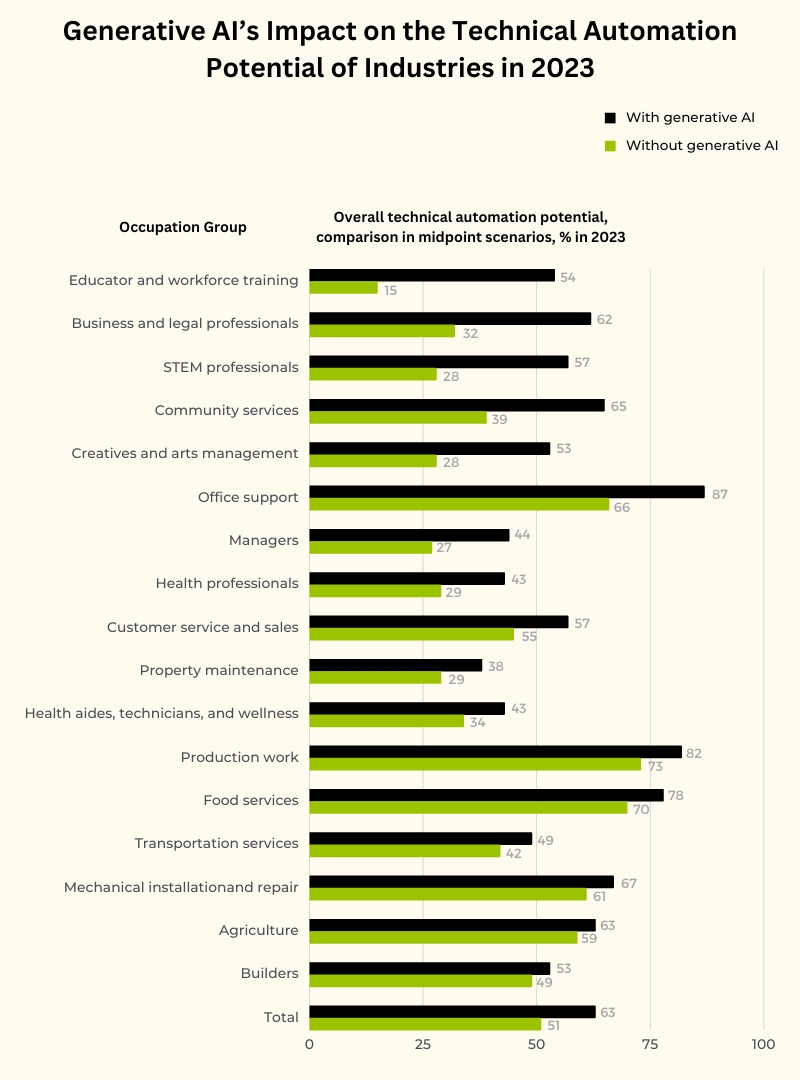
Expand Your Business With the Technology That Grows With Your Requirements
Partner with us and tap into the possibilities of digital transformation
Things to Consider When Designing an AI-Driven Business Strategy
When integrating AI-driven solutions, you must first understand the new digital trends and then design a perfect strategy per your business. Your approach must be designed keeping your current resources and the digital expertise of your employees in mind. Some essential things to consider before implementing new digital strategies are:
What Adds Value?
The question “What adds value to my business?” should be the central focus when implementing AI-driven solutions in your current infrastructure. Since AI integration is no easy feat, you need to make the most out of your investments by evaluating the pros and cons of every step and decision.
The current digital landscape is both static and dynamic regarding newer advancements. So is Artificial Intelligence. It is doing both, optimizing the current business operations while setting up the foundational ground for future opportunities.
So, do not just jump right in because your competitor is doing so. Instead, analyze, plan, and implement after thoroughly considering how it will change your business operations.
Also envisioning the long-term plan, like, how the current investment will impact the business in five years or so. It will help you get a good estimate of the cost incurred and how all the current transactions will take shape to your benefit.
The Expertise of Your Current Workforce
AI and the smart tools powered by it are the new digital currency for business growth and expansion. It holds no value if not utilized well. If you keep upgrading your digital infrastructure, but your employees aren’t able to understand how to use it, then it will not yield the desired results.
This is why it is important to ensure that introduction to new technologies is followed by required training and resource allocation. This will ensure you get the desired results and motivate employees to try the new resources.
Just like how custom mobile app development was once a new concept that slowly got integrated so well that it has become the new norm of mobile app development solutions; similarly, Artificial Intelligence is something that people are still getting used to. It will take time but eventually become a staple of any organization’s seamless operations.
A large fraction of today’s workforce is not technologically aware, though they are knowledgeable and can be a valuable asset to a company’s growth. These people should be trained, so their knowledge can be combined with the current technology to create innovative solutions.
The Ethical Dilemma
Each new change, every action, and all technological advancement brings a set of ethical dilemmas and various questions that cannot be answered with a concrete yes or no. These questions take up massive space in our minds.
They guide our actions and ensure that the digital solutions created by us are within the realm of ethical and moral constructs. Even when it comes to AI integration, numerous things require attention, like:
- Biased Results
There are many instances where AI delivers biased stereotypical results based on gender, ethnicity, class, caste, etc. It raises many important questions, like how can these biases be minimized and more equalized results can be generated. It also questions how a certain group of people is misrepresented based on certain assumptions as the data fed to these AI models is in the end, human-generated. - AI in the Judiciary
This is a highly debatable topic. While some claim it will deliver a fair judgment, many question its inherent bias and unreliability in understanding human rights and values. To add to the advantages, AI will be able to deliver faster and more efficient judgments; however, eventually, the question comes down to its authenticity and how much we can rely on it. - AI-generated Art
AI is making people redefine the meaning of authors and artists. With the capability of designing original and unique pieces based on the guidelines or basic ideas provided, people are now questioning where AI-generated art pieces stand in the domain of the creative field. What exactly will be considered creative, and who can be known as poets authors, and painters? What will be considered a truly original piece? - Wealth Distribution
The rise in the integration of AI and increased automation has been and will continue to cost many their jobs. Thereby reducing the human resources and increasing the profit share per person among the business owners. This will eventually lead to an increased economic gap between the business owners and the salaried employees, thereby making us question how AI's revenue will be distributed and how it can be tackled.
With bespoke solutions and implementation, AI is slowly blurring the line between machine-generated and human-like responses. This can be especially alarming if these advanced technologies fall into the wrong hands. Who will take care of the detrimental effects of AI if it goes out of control and how to avoid it in the first place?
The Artificial Intelligence growth statistics only show constant progress and advancement, which is not a wrong thing but a need of the hour. However, these progressive resources must be regulated with strict rules and regulations. We cannot expect the negative effects to never appear or be handled by themselves.
The only way to ensure that the tools developed for the ease of humans do not start dominating them is to make sure that all the advancements and integrations occur under the bounds of ethics and morality.
Develop and Design Progressive Digital Solutions for Your Business Operations Ethically
Work with a dedicated team that provides innovation driven by a moral compass
To Conclude
Increased integration of AI will witness the emergence of new startups, business ideas, and trends. It will unlock new business opportunities powered by advanced solutions. The recent developments in Artificial Intelligence and statistics clearly prove how fast this technology will advance.
Companies are incorporating AI-driven solutions into their system to maximize profits without exhausting their current resources or investing more. Today relevancy, a strong online presence, customer satisfaction, and digitally upgraded infrastructure are the main pillars of business success. Artificial Intelligence-driven technologies can streamline all of them for you.
However, one important thing to remember is that no matter how advanced AI gets, it will essentially remain a tool to be commanded by humans and not the other way around. So it should never be considered as something to assume the driver’s seat.
As long as the line of ethics and morality is not crossed these advancements will only serve for the benefit of the humans and assist them in reaching their potential.


